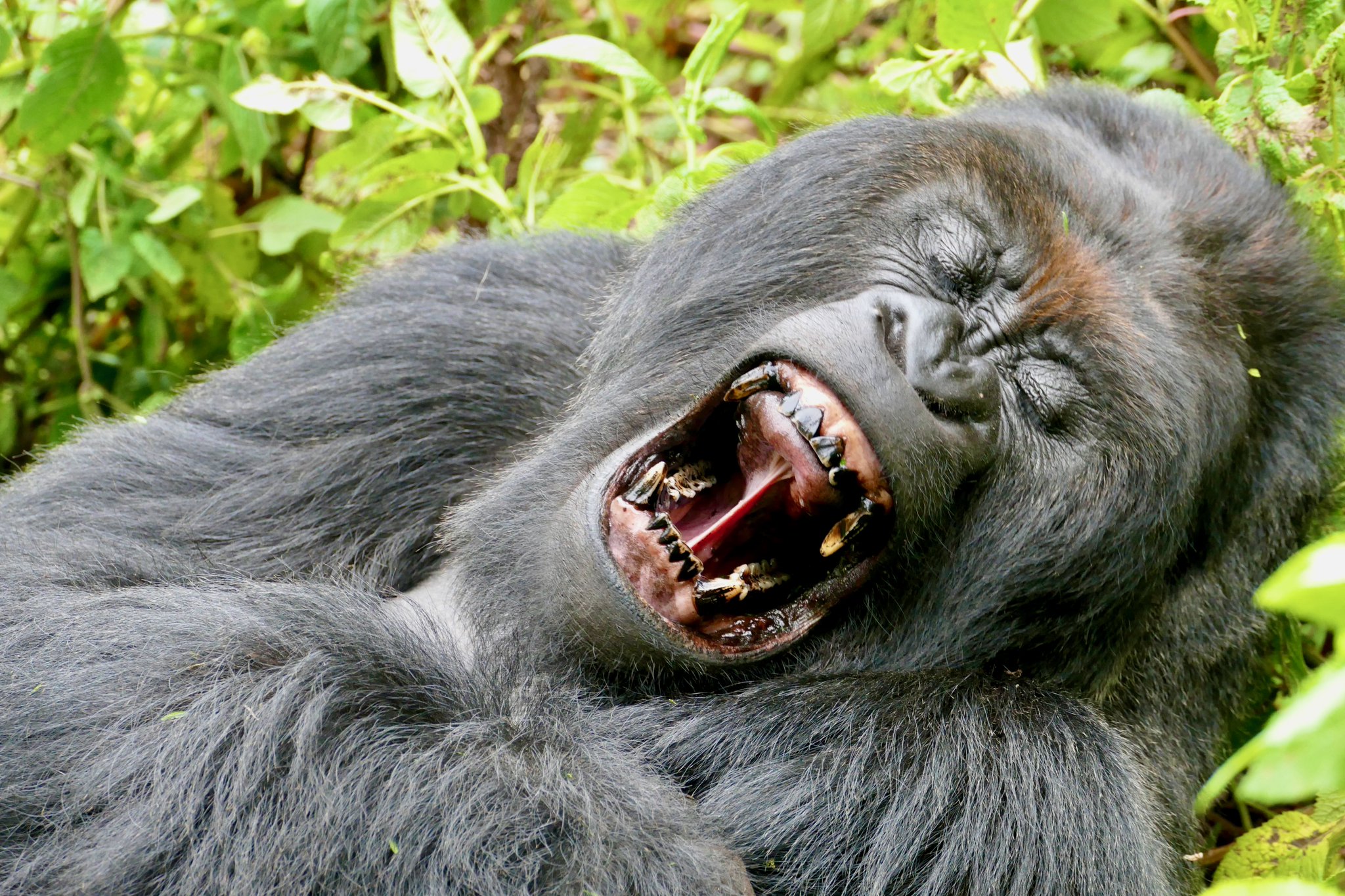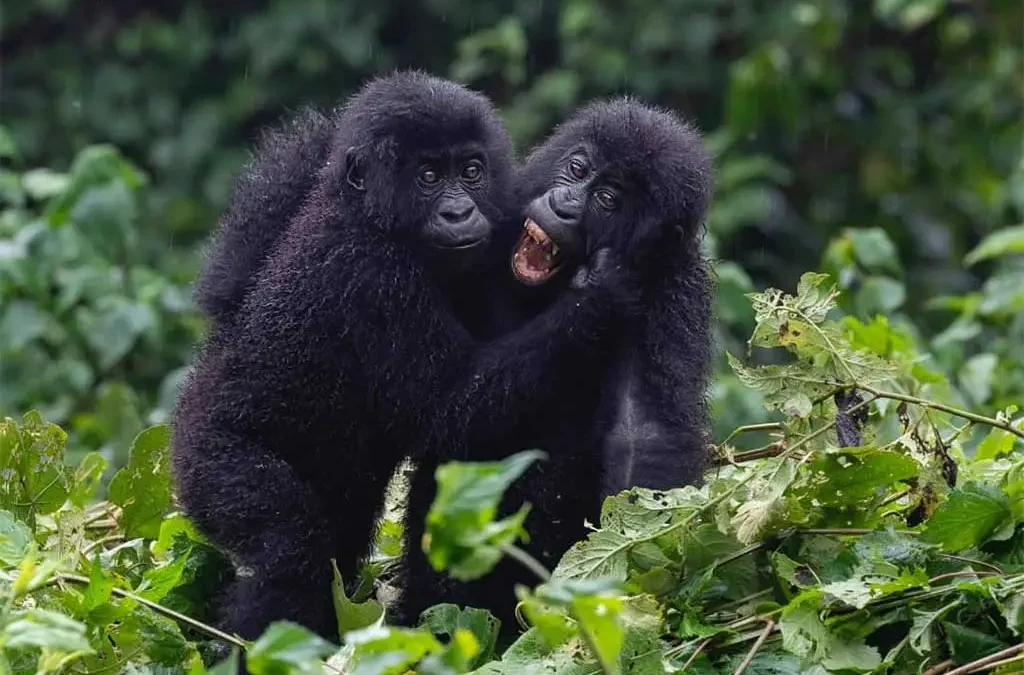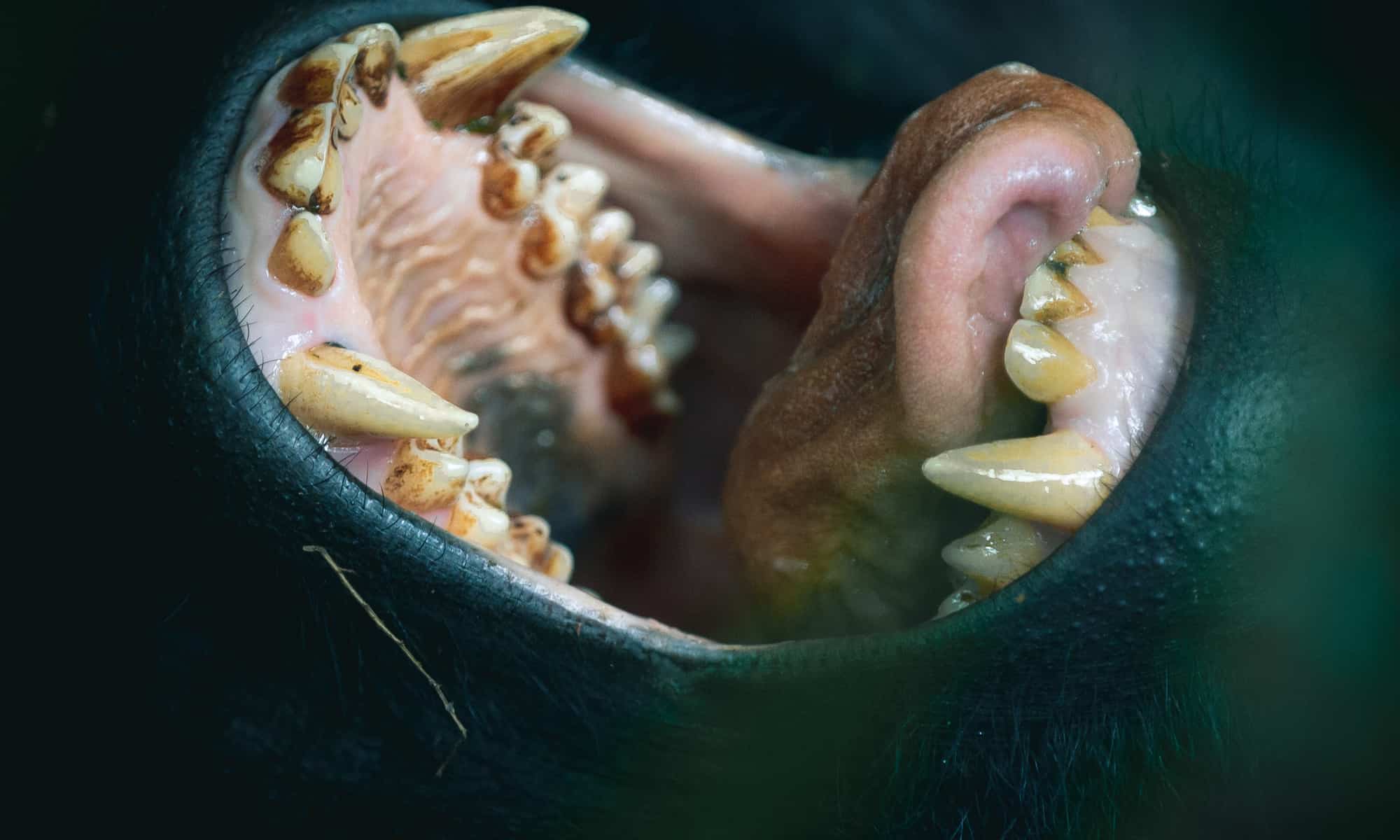Intriguing Facts about Gorilla Teeth: Size, Strength, How many are they, & more
Gorilla teeth are a fascinating subject that provides deep insights into the biology, behavior, and evolutionary adaptations of these great apes. As the largest living primates, gorillas display a distinctive dental structure perfectly suited to their mostly herbivorous gorilla diet of leaves, stems, bark, and fruit.
The impressive silverback gorilla teeth, especially their large canines, not only serve feeding purposes but also play a crucial role in social dominance and defense within gorilla habitats across Central and East Africa.
Understanding gorilla teeth size, shape, and function reveals how these primates have adapted to survive in rainforests, bamboo zones, and montane ecosystems. Studying gorilla teeth also helps scientists learn about health, communication, and the powerful bite force that defines their strength.
Introduction to Gorilla Teeth
Gorillas, belonging to the genus Gorilla, are divided into two species: the eastern gorilla (Gorilla beringei) and the western gorilla (Gorilla gorilla). Their teeth are critical for survival, enabling them to process tough plant material, communicate dominance, and maintain social structures.
With 32 teeth—the same number as humans—gorillas have evolved specialized dental features to suit their herbivorous lifestyle and rugged environments. This article dives deep into gorilla teeth, exploring their structure, function, and significance, making it a must-read for anyone searching for gorilla dental anatomy or primate teeth facts.
Facts about Gorilla Teeth
-
Anatomy of Gorilla Teeth
How many teeth does a gorilla have?
Gorillas possess 32 teeth, mirroring the human dental formula (2 incisors, 1 canine, 2 premolars, 3 molars per quadrant). These teeth are categorized as:
- Incisors: Used for biting and cutting plant material.
- Canines: Large, sharp, and prominent in males for display and defense.
- Premolars: Aid in crushing and grinding.
- Molars: Broad and flat, designed for grinding fibrous vegetation.
Gorilla teeth Size and Strength
Gorilla teeth are proportionately larger and stronger than human teeth, adapted to process coarse, fibrous plants. For example, eastern lowland gorillas have larger teeth than western lowland gorillas, reflecting dietary and habitat differences. Adult male gorillas, or silverbacks, develop canine teeth up to 2 inches long, used more for social displays than feeding.
Tooth Morphology
Studies show variations in gorilla tooth morphology across subspecies. Mountain gorillas and Grauer’s gorillas have duller molar cusps, forming longer crests when worn, which enhance cutting surfaces for fibrous foods. In contrast, western lowland gorillas have sharper cusps, suited for a fruit-heavy diet. These differences highlight how gorilla teeth adapt to specific ecological niches.
Dental Development
Gorillas have two sets of teeth: deciduous (baby) teeth and permanent teeth. Deciduous teeth are replaced by permanent ones as gorillas mature, with molars emerging around 3-6 years. Stress events, like illness or malnutrition, can leave accentuated lines in teeth, providing a record of a gorilla’s life history.
Why are gorillas’ teeth so sharp?
Gorilla teeth, particularly canines, are sharp to serve as display tools for dominance and defense, not for feeding. Large, sharp canines in male eastern gorillas and western gorillas deter rivals and protect groups.
While their molars grind fibrous plants, sharp canines signal strength in social interactions, reflecting evolutionary adaptations for survival and mating success in competitive environments.
How strong are gorilla’s teeth?
Gorilla teeth are incredibly strong, designed to crush and grind tough, fibrous vegetation like leaves, stems, and bark. Eastern gorillas have larger, more robust teeth than western gorillas, with molars capable of withstanding significant force. Their canines, especially in males, are durable for social displays, reflecting adaptations for survival.
-
Eastern Gorilla vs. Western Gorilla Teeth
Eastern Gorilla Teeth:
- Mountain Gorilla (Gorilla beringei beringei): These gorillas have teeth adapted for a leaf-heavy diet in high-altitude forests. Their molars have duller cusps, increasing cutting surfaces for fibrous vegetation. Canines are robust, used for displays during territorial conflicts.
- Eastern Lowland Gorilla (Gorilla beringei graueri): Their teeth are larger, with broader molars to process a varied diet of fruits, leaves, and occasional insects. Their tooth morphology is distinct, not merely intermediate between mountain gorillas and western gorillas.
Western Gorilla Teeth:
- Western Lowland Gorilla (Gorilla gorilla gorilla): These gorillas have sharper molar cusps, ideal for a fruit-based diet. Their teeth are smaller than those of eastern lowland gorillas, reflecting less need for processing tough vegetation.
- Cross River Gorilla (Gorilla gorilla diehli): Less studied due to their rarity, their teeth resemble those of western lowland gorillas, adapted for softer plant material.
Key Differences: The eastern gorilla vs western gorilla teeth comparison shows eastern gorillas have larger, duller teeth for fibrous diets, while western gorillas have sharper, smaller teeth for fruit-heavy diets. These adaptations reflect their distinct habitats and dietary preferences, with eastern gorilla teeth showing greater robustness.

-
Dietary Influences on Gorilla Teeth
Dietary Variations:
Gorillas are primarily herbivorous, but their diets vary by subspecies:
- Mountain Gorillas: Consume up to 30 kg of leaves, stems, and bark daily, requiring strong molars for grinding.
- Eastern Lowland Gorillas: Eat more fruits, supplemented by leaves and insects, necessitating versatile teeth.
- Western Lowland Gorillas: Favor fruits, with occasional insects, leading to sharper molar cusps.
- Cross River Gorillas: Similar to western lowland gorillas, with a fruit-heavy diet.
Impact on Tooth Morphology
The fibrous diet of mountain gorillas results in teeth with duller cusps and longer crests, enhancing cutting efficiency. In contrast, the fruit-based diet of western lowland gorillas favors sharper cusps for softer foods. Dental macrowear studies, using techniques like Occlusal Fingerprint Analysis (OFA), show how tooth wear reflects long-term dietary habits.
Tooth Wear and Diet
Gorilla teeth experience macrowear, a cumulative process reflecting diet and environment. For example, mountain gorillas show less enamel loss due to their soft, leafy diet, while abrasive particles in roots accelerate wear in some populations. These patterns help researchers understand dietary adaptations and ecological diversity.
-
Role of Gorilla Teeth in Social Behavior
Canine Teeth and Dominance:
Gorilla canine teeth play a crucial role in social displays. Silverbacks use their large canines (up to 2 inches) to signal dominance, deter rivals, and protect their group. These teeth are not typically used for feeding but for baring in threat displays, especially during mating competitions.
Play Faces and Teeth Exposure
Western lowland gorillas exhibit a “full play face,” exposing upper teeth during intense play, blending play and submission signals. This behavior, studied in captive gorillas, suggests teeth facilitate communication and social bonding.
Gender Differences
Male gorillas develop larger canines than females, reflecting sexual dimorphism. Despite size differences, tooth shape shows no significant variation between sexes within subspecies, emphasizing functional consistency.
-
Dental Health and Care in Captive Gorillas
Dental Issues in CaptivityCaptive gorillas live longer (up to 50 years vs. 30-40 in the wild), increasing the risk of dental issues like cavities and abscesses. For example, a 23-year-old western lowland gorilla named Binga required molar extraction for an abscess. Regular dental checkups are essential, as gorillas mask distress to avoid appearing weak.
Dental Hygiene Practices
Zoos like Zoo Atlanta train gorillas to accept toothbrushing, using fluoride-free toothpaste and rewards like grapes. This process, which can take months, desensitizes gorillas to brushes and ensures dental health.
Veterinary Interventions
Dental procedures, such as root canals and extractions, require anesthesia due to gorillas’ strength (e.g., 185 kg of muscle in Binga). These interventions are critical for maintaining dental health and preventing infections.
-
Evolutionary Significance of Gorilla Teeth
Gorilla teeth vs human teeth
Gorilla teeth and human teeth both number 32, with similar dental formulas (incisors, canines, premolars, molars). However, gorilla teeth are larger and stronger, adapted for grinding fibrous plants, with robust molars and duller cusps in eastern gorillas for leafy diets.
Human teeth suit an omnivorous diet, with smaller canines for less social display. Gorilla canines, especially in males, are prominent for dominance, while human teeth experience less wear due to processed foods and dental care, unlike gorillas’ natural yellowing from tannins.
Fossil Evidence
Fossil teeth from ancient apes like Chororapithecus (8 million years ago) show similarities to modern gorilla teeth, suggesting early adaptations for plant-based diets. Dental studies, like those on Australopithecus afarensis, reveal how tooth morphology informs evolutionary relationships.
Dental Topographic Analysis
Techniques like dental topographic analysis measure tooth surface attributes (e.g., slope, relief), comparing worn gorilla teeth to those of early hominins. This helps infer dietary adaptations and evolutionary trends, showing how gorilla teeth evolved for specific ecological roles.
-
Conservation and the Role of Dental Studies
Dental Studies in Conservation
Gorilla teeth provide valuable data for conservation. Wear patterns help estimate age, identify individuals, and infer diets, aiding in tracking populations. For example, mountain gorilla teeth show low deterioration, indicating adaptation to soft diets, which informs habitat preservation strategies.
Gorilla threats
Both eastern gorillas and western gorillas are critically endangered due to habitat loss, poaching, and disease. Dental health reflects environmental stress, with abrasive diets accelerating wear in fragmented habitats. Conservation efforts, like those by the Dian Fossey Foundation, use dental data to monitor gorilla health.
Supporting Conservation
Protecting gorilla habitats ensures healthy diets and dental health. Organizations like the African Wildlife Foundation promote ecotourism and anti-poaching initiatives, preserving the ecosystems that shape gorilla teeth adaptations.

-
Key Facts About Gorilla Teeth
| Aspect | Details |
| Number of Teeth | 32, same as humans (incisors, canines, premolars, molars). |
| Canine Size | Up to 2 inches in males, used for display and defense. |
| Molar Morphology | Duller cusps in eastern gorillas, sharper in western gorillas. |
| Dietary Role | Grinding fibrous plants; sharper cusps for fruit in western gorillas. |
| Dental Wear | Reflects long-term diet; used to study ecological diversity. |
| Conservation Use | Age estimation, individual identification via tooth wear. |
Why do gorillas have yellow teeth?
Gorilla teeth appear yellow due to natural staining from their plant-based diet, which includes leaves, bark, and fruits rich in tannins. These compounds cause discoloration over time.
Unlike humans, gorillas lack dental hygiene practices, leading to plaque and stain buildup. Eastern gorillas and western gorillas both experience this, with tooth wear from fibrous foods contributing. Yellowing is a normal sign of age and diet, not poor health.
silverback gorilla teeth vs female gorilla teeth
Silverback gorilla teeth are larger and more robust than female gorilla teeth, reflecting sexual dimorphism. Silverbacks, whether eastern or western gorillas, have prominent canines (up to 2 inches) used for dominance displays and defense.
Female canines are smaller, less pronounced, and primarily functional for feeding. Both have 32 teeth, with similar molar and premolar shapes for grinding fibrous plants, but silverbacks’ teeth are stronger to support their larger size and social role.
Conclusion
Gorilla teeth are a window into the biology, behavior, and evolution of these incredible primates. From the robust molars of eastern gorillas to the sharper cusps of western gorillas, their teeth reflect adaptations to diverse diets and habitats.
Understanding gorilla dental anatomy not only deepens our appreciation for these animals but also supports conservation efforts to protect them. Whether you’re researching gorilla teeth, primate dental adaptations, or planning a gorilla safari, this guide covers it all.
Visit Gorilla Habitats today!
Embark on an unforgettable journey with Hail Tours Uganda to witness the power of gorilla teeth in action! Our eco-tours in Rwanda and Uganda bring you face-to-face with eastern gorillas and western gorillas in their natural habitats.
Learn about their dental adaptations and support conservation efforts. Book now at maranathatours.com and experience the wonder of these primates up close!



